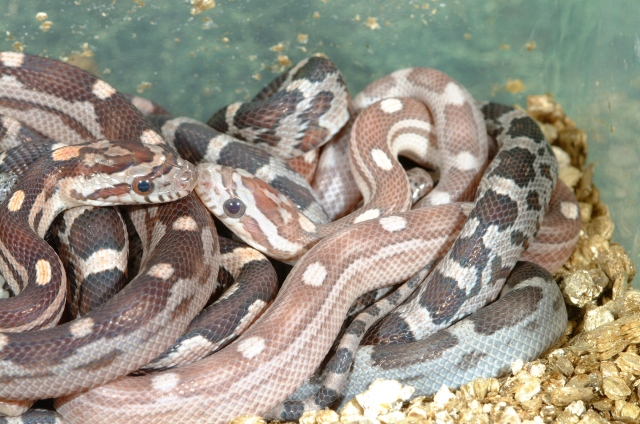i'm not the expert...
well obviously you can learn just about everything that's known about lavender corns from the link off the front page at
www.cornsnakes.com.... I don't profess to be the expert here, either. I can share some observations, though:
I do know that motley is a "simple recessive gene" in that to "express" (i.e. be visually apparent that the snake posesses the gene) the carrier MUST be homozygous for the gene; what that means, is that the carrier MUST have obtained the ressesive version of the gene (as opposed to the dominant version) from BOTH parents. So, if you breed a motley to a motley (i.e. both breeders are homozygous-recessive) then their progeny will be 100% motley. Breed a pair with one homozygous and the other only "het" or heterozygous then you will get 1:2 "normal" and 1:2 "Homozygous-recessive" (i.e. motley). You can also breed two "hets" and 3:4 of the progeny will be "normal" (although with a chance at also being "hets") and 1:4 will get the combined recessive genes to become a "motley". Obviously there's no real point in breeding a "het" carrier to a "normal" because although a portion of the progeny will likely be "hets" you would need years of patience and specific breeding trials to find out who is who (this would ONLY be practical if you had a completely unheard of gene that you were working with, otherwise you'd just get your snake a "het" or "homo" partner from an other breeder.)
Now, I hope I haven't lost you yet... I know that's a bit thick, and since I never was much fer book lernin I might not be the best person to attempt to describe it. But if you ARE still with me, go through the above paragraph and replace every instance of motley with lavender. I don't know for a fact that lavender is a true "simple recessive" gene, but for all practical purposes I think it can be described to behave as such. So this FINALLY brings me to a more concise answer for your question....
If you want a lavender motley, you either need to wait patiently as Rich (and other breeders?) build their personal stock to the point where they feel they can begin to sell them, OR get yourself a couple or few motleys, and a couple or few lavs (really, 2.2 or 3.3 would be much better) and begin the process of converging a pair of morphs which would entail creating an F1 generation of snakes that are 100% normal double hets. Once the F1 generation is breeding, it's just like the double-het pairing I describer above... only to the power of 2... that's because you have two distinct genes you're working with now. So, give me a sec to whip out my GnP Calc...
Youd get progeny in roughly these percentages:
25% double-het
12.5% motley het lav
12.5% normal het lav
12.5% lav het motley
12.5% normal het motley
6% lav
6% motley
6% normal, non-het
6% lavender motley!
So, to extrapolate, if you have a pair of snakes that are double-het lav-motley, and you are lucky enough to get them to breed with each other, and you get an average clutch of a dozen good eggs, you have a (I'm not a mathmetician) what, 1 in 60 chance of getting a single lavender motley?
You can see how the effort Rich and other breeders put into their projects is no joke, let alone the demands for space and attention, and that's just ONE up-and-coming morph.... There are projects Rich is working on most of us are completely unaware of too, I'm sure.
DISCLAIMER: As I said, I'm not claiming to be an "expert". If you see an error in what I posted I've really like to know about it, but I think I got it all out straight....
^Curtis


